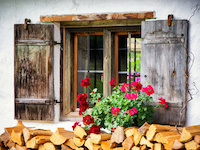 It was about this time of year that our father began to start talking of the winter’s firewood.
It was about this time of year that our father began to start talking of the winter’s firewood.
Already, he had carefully stacked away more than 2000 hay-bales in the big creosote-black hayshed down near the old house. And always, when he saw the last bales carefully piled up in that shed he, like every other farmer before and since, heaved a massive sigh of relief and satisfaction – he now knew that, come what may, his stock would be well-fed during the coming winter. Only a farmer can understand how good and comforting that feels.
But then, within a few short weeks there were new, seasonal things to cope with. It is ever the way of living on the land – one is very much guided, led and impelled by the seasons, and it is a very unwise country man or woman who does not heed the subtle but insistent bidding of those implacably-revolving seasons.
By February up the Otewa Valley, our farm and the land around us was beginning to dry out and the paddocks suddenly and quickly were picked clean down to stubble where before, in October and November, lush clover, rye, Yorkshire fog, lotus major and other grasses had been half a long gumboot deep and thick enough to have to wade through. Over the boundary fences, the adjacent sheep-farms of neighbours Noel and Jack were now mown clean and neat by white flocks of ewes and well-grown lambs, and winding across their much larger paddocks were the artistic narrow sheep trails.
Several times a day long strings of single-file sheep could be seen wandering slowly along these tracks, going to or from the much-used water troughs. My brother and I loved to secretly clamber over the boundary fence and run along these sheep tracks for the sheer joy of it – they carried a layer of fine dirt, ground to talc-powder consistency by the sheep’s sharp feet, and it was almost too hot to walk on under the blazing afternoon sun. The powder would squirt up between our horny, tough-skinned toes, the same as all country kids had, and it would spill over the tops of our feet, nearly burning the skin and requiring us to skip onto the stubble-grass for some vague relief from the heat.
Cow-tracks on our dairy farm were like that too, but they were wider and the dust wasn’t quite so finely ground. Besides, they often carried other more odorous deposits which tended to squelch up on to the shins if one wasn’t careful. The little black sheep pellets were less inclined to stick – or stink, for that matter – but a trail of cow droppings could cover several yards of track and rather spoil the otherwise pleasant, clean fun of it all.
Yet those hot late summer days foretold colder times ahead, and our father, being a prudent man, always had an eye to the future of his farm and his family. So it was about this time of year that we – he, me, my brother and any other family member not otherwise engaged in vital work elsewhere – were required to get on with the business of laying in firewood for winter. All during the preceding 12 months any and all bits of wood found lying around the farm or deemed surplus to requirements, were systematically heaped up in a growing pile near the dog-kennels under the pines ‘out the back’, behind the house enclosure. It included large and small branches that had fallen or been trimmed from the hundreds of trees around the farm; there were slabs of timber and even whole logs that had surfaced in one or other of the several swamp paddocks; there were split or broken battens from mended fencelines; there were broken posts and the off-cuts from fencing footings or new gates that had been built or railings at the cowshed that had been replaced. It all went into the ‘wood-heap’ to be eventually cut and split ready for winter fires. Pinecones too were collected by the bagful.
I have early memories of my father and grandfather working together on the big two-man Tasmanian-toothed saws that Grandpa fitted with straight manuka-stake handles which were polished and worn smooth from hours of hard farmers’ hands working on them. Well-sharpened and wielded by experts – which included Dad and Grandpa – that saw could sing its way through a big gum branch or a dried swamp-log in less than 90 seconds.
Later, we had a massive circular saw, driven at high speed by a heavy six-inch-wide belt that ran from the power take-off at the rear of the Ferguson tractor. The saw was mounted in a bench, and one or other of us stood in front of that spinning, screaming, ravening-toothed blade and shoved the wood into its ripping teeth, a hand either side of the cut. There were no ear-plugs or ear-muffs or protective glasses, and no other safety measures except not doing anything stupid and being totally focussed on the job at hand – all the time. One slip and your hand was off, clean. So you concentrated, hard. The wee bureaucrats from today’s Department of Labour safety section would be apoplectic. They’ve probably never touched anything sharper than a blunt pencil either …
Later still came the 24-inch chainsaw, a marvellous new gadget that was much more manoeuvrable and easier to use than the circular saw and, at least initially, was nearly quieter. Somewhere along the line the muffler came adrift, and the noise level rose considerably. It’s little wonder that these days, most of half a century on, my brother and I both have well-tuned brass bands operating endlessly in our ears. The specialists call it tinnitus, but bro’ and I sometimes tend to be a little more earthy in our descriptions.
In any event, getting that winter firewood in was another major, important milestone in the year’s work. And having the wood sawn up was not necessarily the last of it – the big slabs had to be split into manageable pieces that would fit into the fireplaces in the house. Dad’s axes were always very sharp, my brother or myself spending long minutes winding away on the steel handle of the grind-stone as Dad plied the axe blade first one way and then the other to get both faces equally clean and smooth and leading down to an edge that would shave his arm. It was quality steel. The 40cm grind-stone, with a sandstone face about 10cm wide, ran on a central spindle with half of the spinning stone submersed in a water trough made from a cut-down car tyre. It was a fast and efficient method of putting a good edge on the two axes, both of which were used to split and chop the wood to fire-sized pieces.
For the larger, more knotty chunks, Dad had a hefty maul and half a dozen steel wedges, all varying in size. He’d use the axe to slash a gap in a big knot, then insert one of the wedges and proceed to slam it in with the maul. If that single wedge didn’t split the wood, a second wedge would be driven in beside the first. The maul blows were smashing hits, and it was a rare piece of wood that didn’t fall to pieces quickly under such treatment. Grandpa and Dad used that same maul and wedges to split fence-posts and battens from dried totara and matai logs taken from the swamp, the battens about 6cm square and the posts 20 to 25cm square, the latter being neatly trimmed of their splinters with the axe – always working with the grain of the wood to produce a smooth finish.
Once the firewood was ready, it was all stacked neatly into the woodshed at the back of the fowl-house, there to be eked out by the barrow-load each night once the cold and the rain of a stout King Country winter set in.
And, as always when yet another seasonal job was done, Dad would push his ancient, sweat-stained Aussie wide-awake hat back on his head, put his fists on his hips, raise his chin in acknowledgement of the well-stacked wood, and say quietly: “Good work, boys!”
It was, indeed, high praise.
Kingsley Field is a journalist and published author. He can be contacted at kingsley(at)accuwrite.co.nz
Read more from Kingsley Field here









Join the Discussion
Type out your comment here:
You must be logged in to post a comment.